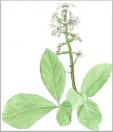Bogbean - Menyanthes trifoliata
This is one of the most beautiful and rare plants that can be admired in Italian fresh waters.
It develops from a long creeping rhizome in usually flooded under-soil, from which grow long, smooth stalks ending in totally emerged, large tripartite leaves which look like a large three-leafed clover, a characteristic that explains its Latin name "trifoliata".
The magnificent flowers are arranged in elongated racemes (812 cm) at the top of the scape which reaches 30 cm in height. Each flower, 1.5-2 cm across, has five white delicately and elegantly fringed petals, tinged with pink.
Menyanthes trifoliata is still relatively frequent in suitable habits in central and northern Europe including the British Isles. In northern Italy it is rare and localised in the peat bogs and the edges of Alpine lakes, whilst it has disappeared completely from the Po Valley.
It is extremely rare in peninsular Italy and now only survives in a few suitable sites in the Apennines as far south as Campania. In northern Tuscany it can be ssen in the Sibolla peat bog where, as in its other localities in the Mediterranean area, it is an ice-age relict.
The leaves of the Bogbean contain a bitter substance used in the past like Gentians for their eu-peptic digestive properties.




